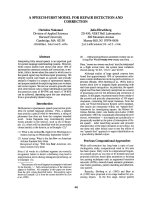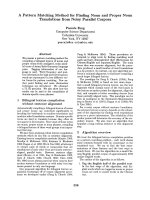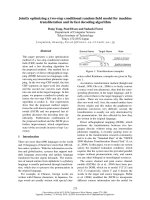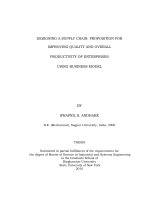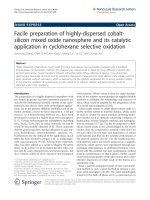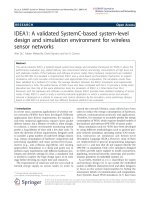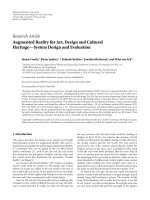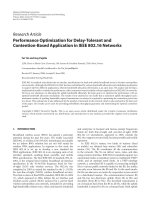A double-loop evaluation process for MOOC design and its pilot application in the university domain
Bạn đang xem bản rút gọn của tài liệu. Xem và tải ngay bản đầy đủ của tài liệu tại đây (517.54 KB, 17 trang )
Knowledge Management & E-Learning, Vol.9, No.4. Dec 2017
A double-loop evaluation process for MOOC design and its
pilot application in the university domain
Federica Cirulli
Gianluca Elia
Gianluca Solazzo
University of Salento, Campus Ecotekne, Lecce, Italy
Knowledge Management & E-Learning: An International Journal (KM&EL)
ISSN 2073-7904
Recommended citation:
Cirulli, F., Elia, G., & Solazzo, G. (2017). A double-loop evaluation
process for MOOC design and its pilot application in the university
domain. Knowledge Management & E-Learning, 9(4), 433–448.
Knowledge Management & E-Learning, 9(4), 433–448
A double-loop evaluation process for MOOC design and its
pilot application in the university domain
Federica Cirulli
Department of Engineering for Innovation
University of Salento, Campus Ecotekne, Lecce, Italy
E-mail:
Gianluca Elia*
Department of Engineering for Innovation
University of Salento, Campus Ecotekne, Lecce, Italy
E-mail:
Gianluca Solazzo
Department of Engineering for Innovation
University of Salento, Campus Ecotekne, Lecce, Italy
E-mail:
*Corresponding author
Abstract: The diffusion of Massive Open Online Courses (MOOCs) is
significantly changing the way people learn and update their knowledge and
competencies. Although the benefits characterizing MOOCs, which leverage on
free and open access to know-how and digitized materials, there are some
challenges which call for improving and enhancing the existing methods and
approaches for MOOCs design. By combining theory and practice, this paper
presents a process of MOOCs design based on a double-loop phase of
evaluation. Specifically, the paper provides evidences on how to take advantage
of the learners’ and teachers’ feedback to redesign or rethink the course’s
architecture, and especially the storyboard and blueprint. A pilot application of
the proposed approach has been made to design a course dealing with
entrepreneurship domain, and in particular with crowdfunding. The results of
the application are presented to validate the approach and provide teachers and
course’s designers with some recommendations.
Keywords: Carpe Diem; Design; Evaluation; Massive open online course;
MOOC
Biographical notes: Federica Cirulli is Research Fellow at the Dept. of
Engineering for Innovation at the University of Salento (Italy). She received
her PhD in “Pedagogy and Education” from the University of Foggia and she
made research activities in collaboration with the GReMS at the Université
Catholique de Louvain (Belgium). Her areas of interest are instructional design,
online learning, and MOOCs.
Gianluca Elia is Assistant Professor at the Dept. of Engineering for Innovation
at the University of Salento (Italy). His research and teaching focus on
Knowledge Management, Technology Enhanced Learning, and Technology
434
F. Cirulli et al. (2017)
Entrepreneurship. He has been research affiliate at the MIT Centre for
Collective Intelligence, and visiting researcher at the Peking University
(Beijing). Since 2001, he teaches in academic and corporate programs.
Gianluca Solazzo is Research Fellow at the Dept. of Engineering for Innovation
at the University of Salento (Italy). His research focuses on Enterprise Software
Architecture, design and implementation of e-Learning platform. With 10+
years of experience in European and Italian research projects, he is currently
focused on Big Data solutions for e-Learning domain.
1. Introduction
MOOCs are a meaningful trend in education (Alario-Hoyos, Pérez-Sanagustin, Cormier,
& Delgado-Kloos, 2014). They integrate the connectivity of social networking (Siemens,
2005) with the accessibility of acknowledged domain experts and the availability of
freely accessible online resources (McAuley, Stewart, Siemens, & Cormier, 2010). The
term was used for the first time in the “Connectivism and Connective Knowledge”
module (Cormier, 2008), at the University of Manitoba, and involved about 2200 online
students. Afterwards, the number of open courses increased significantly, ensuring both
the reliability of sources and the quality of contents (Stracke, 2014). MOOCs are a viable
solution to provide worldwide access to educational credentials, thus contributing to
overcome the economic barriers to instruction (Mazoue, 2013) and revolutionizing the
entire training sector (Peters & Seruga, 2016). MOOCs enable teaching and learning
processes by offering a dynamic context that merges the highly organized and structured
classroom environment with the chaotic open web of fragmented information (Siemens,
2013). These courses can transform training by giving excellent choices for free
education without any boundaries (Peters & Seruga, 2016). Indeed, the openness of
MOOC-based programs favours the democratization (DeWaard et al., 2011) and
commodification of education (Macleod, Sinclair, Haywood, & Woodgate, 2016), even if
this does not imply that contents do not have to be well organized (Laurillard, 2014).
A successful example of MOOC-based initiative is the MIT OpenCourseWare
(www.ocw.mit.edu), launched by the Massachusetts Institute of Technology in 1999 (De
Freitas, Morgan, & Gibson, 2015). Other more recent and equally well-known MOOCs
initiatives are Coursera, edX, Udacity, Futurelearn, P2P University, Open Learning
Initiative, and Stanford eCorner (Liyanagunawardena, Adams, & Williams, 2013;
Rodriguez, 2012).
Students attend MOOCs for different reasons, such as spreading their knowledge
of a topic, completing personal task, acquiring particular qualifications, or simply
satisfying curiosity about this emerging trend (Hew & Cheung, 2014). However, together
with undeniable advantages, there are some open issues related to MOOCs that should be
considered, such as the disequilibrium of the number of enrolments compared to the level
of courses’ completion, and the recognition of a growing number of legitimate peripheral
members who expect to take more dynamic and central roles (McAuley, Stewart,
Siemens, & Cormier, 2010).
From these issues, some key challenges for MOOCs providers arise (Daradoumis,
Bassi, Xhafa, & Caballé, 2013) such as:
•
the heterogeneity of MOOC students, so that the design and delivery of courses
have to consider the different educational and cultural backgrounds of learners;
Knowledge Management & E-Learning, 9(4), 433–448
435
•
the limited participation of teachers in the delivery phases, which can contribute
to the high dropout rate of learners;
•
the high level of courses’ abandons that accounts percentages from 85% to 95%;
•
the lack of a deep analysis of the learning dynamics, since there is not yet an
extensive literature on learning analytics applied to MOOC;
•
the evaluation process, which may have limitations due to the risk of cheating in
performing the tasks.
These challenges call for the need to improve the existing models and approaches
for MOOC design and evaluation. Framed in this context, the paper provides evidences
on how to take advantage of learners’ and teachers’ feedback to redesign or rethink the
course’s structure through a double-loop based approach (Espada, García-Díaz, Castillo
Rodríguez, & González, 2014). Indeed, the main research question investigated in this
study can be defined as follows: How can learners and teachers be effectively involved in
the process of MOOC design?
The paper is structured as follows: the relevant literature concerning MOOC
design and evaluation is presented in the next section, with a specific description about
the widely adopted Carpe Diem method (Salmon, 2013; Salmon, 2014; Salmon, Gregory,
Lokuge Dona, & Ross, 2015). Section 3 describes the research method, whereas section 4
presents the double-loop process of evaluation that extends Carpe Diem. Finally, section
5 presents a pilot application of the approach proposed within the university domain.
Discussions and conclusions are drawn in the last section of the paper.
2. Theory background
The theory background of the paper is centred on principles and approaches for MOOC
design, including the evaluation aspects, with a deep investigation on the Carpe Diem
method, which has been widely adopted in the last years for designing MOOCs.
2.1. Principles and approaches for MOOC design and evaluation
By adopting a pedagogical perspective, MOOCs represent the virtuous integration of two
growing trends: the online learning, which has been important since the beginning of
twenty-first century (Butcher & Wilson-Strydom, 2013), and the Open Educational
Resources (Yuan & Powell, 2013), which include learning content, tools and
implementation resources (Hylén, 2006; Pawlowski & Bick, 2012). Further, the diffusion
of MOOCs allows setting up new educational approaches and design methods for on line
courses, as widely discussed in the literature (Macleod, Sinclair, Haywood, & Woodgate,
2016).
Design is here conceived as the whole process that provides the structure of the
overall learning experience, including the contents to be delivered, the learning tools
supporting the process, the environmental conditions, and the expected learning goals
(Alonso, López, Manrique, & Viñes, 2005).
Fischer, Bruhn, Grasel, and Mandl (2002) suggest design strategies for sociotechnical systems aimed at motivating participation by leveraging on social exchange and
cooperation. Specifically, the key elements of their approach are meta-design (realized
through a collaborative approach in the course design), social creativity (aimed at
436
F. Cirulli et al. (2017)
sustaining real cooperation among learners), and participation intensity (based on
different levels of users’ engagement with the platform and content).
According to Siemens (2006), MOOC design is the process of creating networks,
where nodes represent external entities such as people, organizations, archives, links,
books, papers, catalogues, or any other source of information. With such approach,
MOOC design refers to the course structure, in which the contents form a cluster of
resources around a specific topic (Downes, 2009).
Hill (2012) places MOOCs within a landscape of educational planning methods
that reveal the role of educational technology and instructional design (Guàrdia, Maina,
& Sangra, 2013). The main idea of this approach is to involve participants in creating and
sharing information in a connectionist manner (Fidalgo Blanco, García-Peñalvo, & SeinEchaluce, 2013). The design of this type of courses is grounded on four main principles
(Kop, 2011): the collection and aggregation of information and resources; the sensemaking to connect knowledge, practice, people and contents with each other; the
repurposing of resources to generate a digital artefact and create new knowledge; and
finally, the sharing on the web of the new resources created.
Conole (2013a) proposes the 7Cs Learning Design framework with the purpose to
enhance learner experience and to guarantee courses’ quality. The framework includes
the following seven phases: Conceptualise (to explicate the aim of the course), Capture
(to create the resources), Communicate (to create the communication tools), Collaborate
(to create the collaboration tools), Consider (to create the assessment tools), Combine (to
review and adjust resources and tools), and Consolidate (to test the efficacy of the course
delivery).
MOOCs design becomes a catalyst to implement the change from traditional
approach of teaching to precision-based perspectives (Mazoue, 2013), which includes
teamwork activities, discussion forums and netiquettes for students during discussions or
any other collaborative activities. About the use of technology, there has been a
considerable amount of research on learners’ involvement and opinions (Oblinger &
Oblinger, 2005; Biggs & Tang, 2011; Conole, 2013b). These studies show that learners
consider technologies as an indispensable tool for learning, and that they are able to use
strategies for self-organisation and for collaboration with peers. In such a perspective, the
main target of the MOOCs design process should be to ensure the learners to participate
actively to the learning experience, with a high level of motivation and enthusiasm, and
without being passive receivers of information. When these conditions are ensured,
students will be engaged with the courses that they are taking (Doherty, Harbutt, &
Sharma, 2015).
As for the MOOCs evaluation, Bernal, Molina, and Pérez (2013) require that it
should be based on the same quality criteria applied in open, formal and distance courses.
The fact that they are massive, open and online requests a great rigor in checking their
quality to satisfy different users, by considering the scarcity of capabilities to analyse the
results and the attainment of the learning objectives (De la Garza, Sancho-Vinuesa, &
Gómez-Zermeño, 2015). MOOCs evaluation can show significant methodological and
interpretive views. Gomez, Callaghan, Eick, Carchidi, Carson, and Andersson (2012)
take into account indicators related to pedagogical, functional and technological elements.
Cross (2013) adopts another evaluation perspective aimed at seizing and representing the
full range of participants’ point of view rather than focusing on the experience of specific
groups, such as only those ones who finish the MOOC.
Knowledge Management & E-Learning, 9(4), 433–448
437
According to Barbera, Gros, and Kirschner (2012), timing is a critical component
that has to be used as a quality measure, since it refers to the duration of the whole
experience in which people learn and develop practises. Indeed, time regulation is
considered a factor affecting the organisational phases of this type of on-line learning
courses (Franco-Casamitjana, Barbera, & Romero, 2013).
Lastly, according to Pivec and Pernold (2014), MOOCs evaluation should be
focused on students’ requirements, which include the devices they want to use, the social
communities they are active in, and the typology of help or support they expect from
teachers and tutors.
Table 1 synthesizes the basic principles of the main models and approaches used
for MOOC design and evaluation.
Table 1
Principles for MOOCs design and evaluation
MOOC Design
Motivating participation through social
exchange and collaboration (Fischer, Bruhn,
Grasel, & Mandl, 2002).
Creating networks, where nodes are external
entities and can be people, web sites, reports,
databases, etc. (Siemens, 2006)
Clustering of resources around a knowledge
domain (Downes, 2009).
Collecting and aggregating information and
resources, connecting people with other
people and contents, repurposing of resources
to generate a digital artefact and create new
knowledge, sharing on the web the new
resources created (Kop, 2011).
Conceptualising, Capturing, Communicating,
Collaborating, Considering, Combining, and
Consolidating (Conole, 2013a).
Team working, discussion forums, netiquettes
for students, collaborative activities (Mazoue,
2013).
Use of technology to involve learners and
express opinions (Oblinger & Oblinger, 2005;
Biggs & Tang, 2011; Conole, 2013b).
Assuring enthusiastic participation of learners
in the learning experience (Doherty, Harbutt,
& Sharma, 2015).
MOOC Evaluation
Pedagogical, functional and
technological perspectives (De la Garza,
Sancho-Vinuesa, & Gómez-Zermeño,
2015; Domingo Coscollola & Fuentes
Agustí, 2010).
Timing (Barbera, Gros, & Kirschner,
2012; Franco-Casamitjana, Barbera, &
Romero, 2013)
Seizing and representing the full range
of the participants’ point of view, and
not only of the ones who finish the
course (Cross, 2013).
Greater rigor quality criteria like the
ones applied in open, formal and
distance courses (Bernal, Molina, &
Pérez, 2013; De la Garza, SanchoVinuesa, & Gómez-Zermeño, 2015).
Students’ requirements about technical
devices, social communities, and
support from teachers and tutors (Pivec
& Pernold, 2014).
438
F. Cirulli et al. (2017)
2.2. The Carpe Diem method
Carpe Diem is characterised by a framework with progressive stages that can support the
design of online courses (Salmon, 2013; Salmon, 2014; Salmon, Gregory, Lokuge Dona,
& Ross, 2015). Its simplicity has generated a wide appeal and, consequently, the method
has been extensively adopted to design many MOOCs programs and initiatives.
Moreover, it is characterized by high levels of flexibility and originality, which ground
on the presence of skilled collaborative groups called “Carpe Diem Pod Teams”, that are
engaged for innovative learning design (Salmon, 2013). These groups operate as teambased pathfinders, which normally include teachers, designers, subject librarians and
learning technicians, and are helped by a facilitator (Salmon & Wright, 2014).
The main purpose of the method is to support online learning effort, by using
constructivist pedagogic theories. It consists of six phases in which groups are involved
in the creation of MOOCs learning paths (Salmon, 2013; Salmon, 2014; Salmon, Gregory,
Lokuge Dona, & Ross, 2015). Table 2 provides a synthetic description of each phase.
Table 2
A synthetic view of the Carpe Diem method
Phase
1.Writing a blueprint
Description
Teachers in Carpe Diem Pod Teams outline the fundamental
aspects of the courses, explore the impact of the didactic
experience on students, define what is engaging for learners in
each unit, and the overall evaluation process.
2. Making a storyboard
The Carpe Diem Pod Teams create the storyboard, which is the
visual arrangement of each learning unit in which all actions
(e.g. lectures, tutorials, assessment, online activities, etc.) are
clearly organised to motivate participants, promote their online
socialization and exchange of information, foster knowledge
construction, and stimulate self-development. Then, the calendar
for the course delivery is also established.
3. Building a prototype
online
The stand-alone online activities are designed. These activities
refer to online events to improve effective and active learning of
single individuals or groups.
4. Checking reality
Members of each Carpe Diem Pod Teams review and give
feedback to other groups of teachers, thus providing new ideas
and creative perspectives about the clarity of the design of each
learning unit.
5. Reviewing and adjusting
The suggestions and feedback received from the other teams are
read and discussed; if accepted, the team proceed to modify the
learning design, to refine the timing, and, in case, to rethink and
adjust the course’s storyboard or blueprint.
6. Planning your next steps
Each team elaborates an action plan to complete the course and
make it available in the online platform, through specifying the
progress states, the highlighted tasks, time of completion, etc.
Knowledge Management & E-Learning, 9(4), 433–448
439
3. Methodology
The study has been conducted by following the design science research method, which
devotes attention to the development of studies that aim at prescription, project and
artefact building (Dresch, Lacerda, & Miguel, 2015), in the final goal to prescribe
solutions to existing problems, improving or creating new systems (Van Aken, 2004).
Specifically, this method includes six key phases (Hevner, March, Park, & Ram, 2004;
Peffers, Tuunanen, Rothenberger, & Chatterjee, 2006; March & Storey, 2008; Dresch,
Lacerda, & Miguel, 2015): problem identification and definition, solution proposition,
research goal definition, artefact development, demonstration and evaluation, and
research communication.
First, problem identification and definition have been grounded on a literature
review about the MOOCs, in order to explore if current approaches for MOOC design
include teachers’ and learners’ evaluation in the overall process. Specifically, a structured
documents retrieval process (Tranfield, Denyer, & Smart, 2003) has been realized
through launching on Scopus database the search terms “MOOC*”, and “massive open
online course*”, which have been cross-referenced (AND search) with “design”,
“evaluation” and “approach”. Results have been analysed by reading the abstract and
checking if the focus of the article was related to MOOC design and evaluation issues.
Then, a careful reading and deep analysis of the selected articles were performed in order
to identify possible contributions concerning enhancements of MOOC design principles
and phases.
Then, solution proposition has been elaborated by investigating the possibility to
include learners’ feedback in the wide diffused Carpe Diem method for MOOC design,
which is mainly based on the valorisation of teachers’ feedback.
The research goal was defined coherently with the problem identified at the outset
and, in particular, it consisted in the exploration of the ways through which learners and
teachers can be both effectively involved in the process of MOOC design.
The artefact development was realized by introducing a further step in the Carpe
Diem method, by distinguishing the feedback expressed by the teachers from those ones
expressed by the learners. Both feedbacks are considered valuable to improve the overall
process of MOOC design, because they may bring different and complementary
enhancements.
The demonstration and evaluation of the artefact has been organized by involving
a team composed by teachers, instructional designers and technicians, integrated by the
learners involved in an online course on crowdfunding. Each member of this community
answered to a questionnaire designed to receive feedback on the key issues for MOOCs
evaluation. By analysing their comments and feedback, some implications for researchers
and practitioners have been elaborated and included in this article, which represents a
primary contribution for the scientific communication of the work done.
4. Results
The main result of this study consists in an enhancement of the Carpe Diem method
through the introduction of a double-loop evaluation cycle of MOOC design that
leverages both learners’ and teachers’ feedback to improve the didactic and technological
issues of the course. More specifically, the “Checking reality” phase, which involves only
teachers and instructional designers in the Carpe Diem method, now includes also
440
F. Cirulli et al. (2017)
learners of the course that are invited to express their evaluation about the online module
just created. At this purpose, two structured questionnaires have been created and
submitted respectively to learners and teachers, in the final aim to collect their feedbacks
and improve the overall courses’ design (Conole, 2008). Both questionnaires are
organized in three sections, such as didactic issues, technology issues, and overall
evaluation (Liaw, 2008). With the enhancement proposed, phase 4 of Carpe Diem
devoted to the “Checking reality” results split into two phases (4a and 4b), and this
represents the evolution respect to the well-known Carpe Diem method. Fig. 1 shows
graphically this enhancement.
Fig. 1. Double-loop evaluation cycle of MOOC design
As shown in Fig. 1, teachers’ and learners’ feedbacks may have a different impact
on the overall evaluation process. Actually, learners’ suggestions and opinions (phase 4a)
may be considered to revise stage 2 and stage 3 of the method, thus improving and
modifying the storyboard and the online prototype. Teacher’s feedback (phase 4b),
instead, beyond introducing changes at the same levels, can transform also the blueprint,
which refers to the stage 1 of the method and expresses the general outline and the key
aspects of the course.
The collection of teachers’ and learners’ feedbacks has been conducted through
two questionnaires, which have been designed by the authors on the basis of the theory
background to evoke answers over different aspects of the course (Pishvaei & Kasaian,
2013). After, they have been validated by involving three researchers working in the
education domain, and finally transformed into a web-based version for the data
collection.
Specifically, the questionnaire for learners allowed for collecting data related to
didactic issues (content, teaching and mentoring, course organization and assessment),
technological issues (simplicity of use, communication and interaction tools), and overall
evaluation (originality and interest, satisfaction and recommendation), as perceived by
learners. The questionnaire has been submitted to ten undergraduate students enrolled in
the Management Engineering degree.
As for the questionnaire for teachers, it has allowed for gathering information and
opinions related to didactic issues (instructional design choices, effectiveness of elearning approach, role of e-learning to innovate the education, validity of the assessment
phase), technological issues (authoring tools and back-office interaction services), and
overall evaluation (characteristics and services of the course). The questionnaire has been
submitted to two professors acknowledged on the same topic of the course.
Both questionnaires included closed questions with a 1 to 5 Likert scale (1 for the
lowest evaluation, and 5 for the highest evaluation). The period of data collection lasted
15 days, during which both categories of respondents could modify their answers. After
Knowledge Management & E-Learning, 9(4), 433–448
441
the expiration of the validity period, all the submitted answers have been analysed by the
authors, and the final marks were calculated by adopting the average function.
Table 3 illustrates the main items included into the students’ and teachers’
questionnaires.
Table 3
The main items constituting the students’ and teachers’ questionnaires
Item for the students' questionnaire
Clarity of contents
Level of innovation in teaching
Clarity of learning goals
Personalization of the didactic respect to
the learner’s needs
Coherence between learning goals and
contents
Usefulness of additional resources
Didactic Issues
Item for the teachers' questionnaire
Coherence between foreseen and
effective work
Responsibility of learners
Virtual contexts for collaboration,
cooperation, and knowledge sharing
Approach new topics and concepts
Knowledge acquisition
Enhancement of the work of the teacher
Usefulness of tutorship and mentorship
Change of the role of the teacher: from
“content provider” to “designer of learning
experiences”
Typology of assessment
Effectiveness of teacher (competency and
clarity)
Organization of learning activities
Change in competence development
Effectiveness of the learning process
Effectiveness of the role of teacher
Concreteness of the course
Flexibility of the course
Overall Evaluation
Technological Issues
Assessment of the course
Simplicity in using the platform
Accessibility and use of facilities
Access to services
Usability of authoring tools
Communication tools
Graphics
Content management tools
Video
Teacher-learner interactions
Audio
Learner-learner interactions
Teachers - Back Office interaction
Level of involvement respect to
traditional learning
Level of involvement in the course
Level of originality respect to traditional
learning
Overall satisfaction level
Originality of the course
Fatigue
Required technological skills
Interest in participation to the initiative
Satisfaction with logistics and organization
Communication with team members
Level of innovation of the course
442
F. Cirulli et al. (2017)
Both questionnaires have been used to collect feedback from the two targets
(teachers and learners) during the design of an online course. In such a way, a
collaborative design path based on a single and a double-loop of evaluation of the online
course has been experimentally activated.
5. Pilot experimentation
The double-loop evaluation cycle has been implemented in the overall course design
process, in particular within a course on crowdfunding. Thus, the six phases of the Carpe
Diem method have been realized by involving team composed by teachers, instructional
designers, and technicians. The collaborative space of design process has been organized
in the Department of Engineering for Innovation at the University of Salento.
The description of each phase here follows, including the details related to the
pilot application realized in a course on crowdfunding.
I. Writing a blueprint
Team working with teachers, instructional designers and technicians demands initial
planning and coordination efforts. Through a brainstorming process, the key goals and
the essential aspects of the course are conceived, including the target skills. With
reference to the course on crowdfunding, the target skills refer to the knowledge of the
financial instruments to manage the business risk, and to the use of the crowd-based tools
for business financing. A set of keywords for the course has been also identified, such as
startup financing, venture capital, and crowdfunding.
II. Making a storyboard
Course’s architecture is depicted by groups of teachers through the detailed definition of
the main building blocks (modules) and the final assessment. In the course on
crowdfunding, a visual layout has been created in order to visualize the entire structure of
the contents.
III. Building a prototype online
Each group involved develops the online course, with the support of technicians and
instructional designers, and by using specific software and authoring tools. With
reference to the course on crowdfunding, a group of teachers has been involved for the
prototype building. It has developed the module, with interactive digital contents and
audio-video synchronization. The module contains video, slide presentation and a selfassessment tool. Furthermore, additional resources are included as recommended material
(e.g. hand-outs, concept maps, web links, case studies, papers, reports, synthetic
bibliography, studies, webinar, papers, reports), together with some other collaboration
activities (e.g. participation in a virtual classroom).
IV. Checking reality
In this stage, both teachers and students are involved to revise the online modules and
provide their feedbacks. It is in this phase that the double-loop evaluation process is
implemented. Indeed, with reference to the course on crowdfunding, the module has been
evaluated, at the same time, by a group of teachers different from the one engaged for the
prototype building, and a group of learners. Table 4 shows the specific evaluation and
feedback provided by the two categories of actors.
Knowledge Management & E-Learning, 9(4), 433–448
443
Table 4
The synthesis of the evaluation provided by students and teachers
Learners' Evaluation
(1 Lowest - 5 Highest)
Teachers' Evaluation
(1 Lowest - 5 Highest)
Didactic issues
4.34
4.58
Technological issues
3.98
4.92
Overall evaluation
4.07
4.61
V. Reviewing and adjusting
Workgroups analyse the feedback collected through the two questionnaires, in order to
decide how to modify and improve the design phases. Referring to the course on
crowdfunding, most of the answers positively assessed the item related to both
questionnaires.
Students’ answers revealed a high level of satisfaction for what concerns the
elements related to didactic issues (4.34), less satisfaction was expressed as for the
technological tools (3.98). The main modifications suggested by the learners concerned
the improvement of the collaboration services of the system in order to simplify the
online collaboration, and the addition of further resources to know more in detail the
point of view of a crowdfunding platform. Thus, respectively, the integration of skype
call conference service was implemented, and an interview with a manager of a
crowdfunding platform was added in the additional resources of the course. These actions
were implemented to promote a much more satisfactory learning experience.
For what concerns teachers’ feedback, there was a high level of satisfaction for
the elements related to didactic issues (4.58) and technological tools (4.92). The main
suggestion was to add a further target skill devoted to design from scratch a
crowdfunding campaign. In such a way, the blueprint has been integrated, and the online
course was updated to include further concepts, material, and activities strictly related to
the new skill added.
VI. Planning next steps
This phase consists in courses delivering to students. Thus, the MOOC design and
evaluation process can be considered closed, and the modules can be officially uploaded
in the system in order to be delivered. With reference to the course on crowdfunding, the
system and the contents are now ready to be accessed by a wider number of learners.
6. Discussions and conclusion
MOOCs offer a significant opportunity for training of thousands of individuals
worldwide, allowing free online access to education in companies, universities and
informal settings (DeWaard et al., 2011). MOOCs represent a current trend in the elearning domain, and their arrangement is continually improved as more experience is
gained in design methods. MOOCs represent today a positive example to open new
learning chances (Guàrdia, Maina, & Sangra, 2013) by focusing on innovative usercentred course design approaches (Daradoumis, Bassi, Xhafa, & Caballé, 2013).
444
F. Cirulli et al. (2017)
In such a perspective, based on the Carpe Diem method (Salmon, 2013; Salmon,
2014; Salmon, Gregory, Lokuge Dona, & Ross, 2015), which is widely adopted for
MOOCs design, this paper proposes an enhancement by introducing a double-loop
evaluation process that involves not only teachers, but also learners. This approach is
aligned with the recent trends in technology-based instruction, which consider learners’
preferences and perspective of educational feedback as valuable sources of information to
improve an online course (Lefevre & Cox, 2016). In such a way, the double-loop
evaluation process based on the learners’ involvement represents the main difference
respect to the pure Carpe Diem method. Definitely, the proposed approach leverages both
teachers’ and student’s feedback collected during the check reality phase, in order to
refine the course storyboard or blueprint.
The approach has been also applied in a pilot course on crowdfunding, in the aim
to show how it can be profitably adopted. Indeed, during this preliminary application, the
feedbacks expressed by teachers and learners, and collected through a web-based
questionnaire, have been used to enhance part of the online course, in order to finalize it
and make it available to a larger audience.
The logic behind the proposed method can be interpreted within the principle of
user-driven innovation (Prahalad & Krishnan, 2008). Actually, contextualizing this
principle in the online education domain, it allows for considering learners as
fundamental actors to engage for co-designing and co-producing the online course within
real-world settings, thus realizing the co-creation through a virtuous collaboration
between producers and users (Prahalad & Ramaswamy, 2002). This is deeply different
from the traditional collection of users’ feedback since it usually happens at the end of
the course. Instead, in this case, the course’s evaluation process is based on the feedback
expressed by a limited number of teachers and learners, and collected through a webbased questionnaire. These feedbacks allow obtaining a preliminary evaluation about the
course, as well as defining the main enhancements to implement to the course, under the
perspective of both teachers and learners. Respect to the Carpe Diem method that
valorises the teachers’ feedback, the suggested improvement allows considering also the
learners’ point of view, requirements, expectations and feedback, which become a
fundamental input in the MOOC design process, above all for the aesthetic attraction, the
pedagogical effectiveness, the multimedia sources and the multimodal composition. In
such a way, the output of the MOOC design process can have more chance to satisfy a
wider target of learners, and not only teachers, thus providing them consciousness of
learning trajectories (Guàrdia, Maina, & Sangra, 2013).
From a research perspective, this paper explores the opportunity to include also
learners in the design process, thus offering the opportunity to raise awareness of learning
intentions, and explore new ways through which overcoming the MOOCs limitations
related to the assessment process (Hill, 2013), the interactivity between learners and
contents (Grünewald, Meinel, Totschnig, & Willems, 2013), the diversity of MOOC
participants (Conole, 2013b), the absence of face-to-face interaction (Schulmeister, 2014),
and the drop-out rate (Yousef, Chatti, Schroeder, & Wosnitza, 2015). Furthermore, taking
into account the learners’ feedback for MOOCs design, the proposed approach can
support more effectively those MOOC environments where learners can self-organize
and practice networked learning, so taking an active role in the management of their
learning activities (Yousef, Chatti, Schroeder, & Wosnitza, 2015). In such a way, the
enrolment in a MOOC environment can positively affect the use of the system itself and
the student’s achievement (Liang, Jia, Wu, Miao, & Wang, 2014). This could bring to
relevant results related to the transversal skills such as the empowering of learners in
open applications, the encouragement of critical thinking, the consolidation of know-how
Knowledge Management & E-Learning, 9(4), 433–448
445
based on outcomes, and the providing of instruments for self-regulation (Guàrdia, Maina,
& Sangra, 2013).
From a practitioner view, this article presents a method through which realizing a
double-loop phase of MOOCs evaluation. Indeed, suggestions and feedback collected
from teachers and learners can really improve the quality and the effectiveness of the
overall online modules. In such a way, the evaluation process is here considered
fundamental to extend the students’ participation, to support their awareness, to
encourage the development of learner-centred courses and, consequently, to generate
value in MOOCs’ implementation (Nkuyubwatsi, 2013). In particular, due to the high
level of heterogeneity of MOOC learners, the feedback expressed by different profiles of
learners may allow also identifying some parts of the course that can be more suitable to
ensure some degree of course customization (Daradoumis, Bassi, Xhafa, & Caballé,
2013). Moreover, the proposed evaluation conducted before to make a new online course
available to the large audience, may contribute to enrich the overall course by
implementing the suggestions and comments gathered, thus increasing the chances to be
accepted and appreciated by both teachers and learners. Afterwards, traditional approach
for evaluating MOOCs at the end of the learning program can be applied, as the one
proposed by Cross (2013), which bases the MOOC evaluation on a number of
perspectives including participant compliance and deviation from the design, attainment
of design and participant goals, and performance against measures. Besides, the approach
proposed can assist also the software agents that perform a data mining analysis on the
data stored in the MOOC system or in external data sources to provide a complete online
support in the design, delivery and assessment phases (Daradoumis, Bassi, Xhafa, &
Caballé, 2013).
References
Alario-Hoyos, C., Pérez-Sanagustin, M., Cormier, D., & Delgado-Kloos, C. (2014).
Proposal for a conceptual framework for educators to describe and design MOOCs.
Journal of Universal Computer Science, 20(1), 6–23.
Alonso, F., López, G., Manrique, D., & Viñes, J. M. (2005). An instructional model for
web-based e-learning education with a blended learning process approach. British
Journal of Educational Technology, 36(2), 217–235.
Barbera, E., Gros, B., & Kirschner, P. (2012). Temporal issues in e-learning research: A
literature review. British Journal of Educational Technology, 43(2), E53–E55.
Bernal, Y., Molina, M., & Pérez, M. (2013). La calidad de la educación a distancia: El
caso de los MOOC. Revista Iberoamericana para la Investigación y el Desarrollo
Educativo, 3(10), 1–13.
Biggs, J., & Tang, C. (2011). Teaching for quality learning at university: What the
student does (4th ed.). Maidenhead, UK: Open University Press.
Butcher, N., & Wilson-Strydom, M. (2013). A guide to quality in online learning. Dallas,
TX: Academic Partnerships.
Conole, G. (2008). New schemas for mapping pedagogies and technologies. Ariadne.
Retrieved from />Conole, G. (2013a). Current thinking on the 7Cs of learning design. Retrieved from
/>Conole, G. (2013b). MOOCs as disruptive technologies: Strategies for enhancing the
learner experience and quality of MOOCs. Revista de Educación a Distancia, 39: 1.
Cormier, D. (2008). The CCK08 MOOC – Connectivism course, 1/4 way. Dave’s
Educational Blog. Retrieved from />
446
F. Cirulli et al. (2017)
cck08-mooc-connectivism-course-14-way/
Cross, S. (2013). Evaluation of the OLDS MOOC curriculum design course: Participant
perspectives, expectations and experiences. Milton Keynes: OLDS MOOC project.
Daradoumis, T., Bassi, R., Xhafa, F., & Caballé, S. (2013). A review on massive elearning (MOOC) design, delivery and assessment. In Proceedings of the Eighth
International Conference on P2P, Parallel, Grid, Cloud and Internet Computing.
De Freitas, S. I., Morgan, J., & Gibson D. (2015). Will MOOCs transform learning and
teaching in higher education? Engagement and course retention in online learning
provision. British Journal of Educational Technology, 46(3), 455–471.
De la Garza, L. Y. A., Sancho-Vinuesa, T., & Gómez Zermeño, M. G. (2015). Indicators
of pedagogical quality for the design of a Massive Open Online Course for teacher
training. RUSC. Universities and Knowledge Society Journal, 12(1), 104–118.
DeWaard, I., Abajian, S., Gallagher, M. S., Hogue, R., Keskin, N., Koutropoulos, A., &
Rodriguez, O. C. (2011). Using mLearning and MOOCs to understand chaos,
emergence, and complexity in education. The International Review of Research in
Open & Distance Learning, 12(7), 94–115.
Doherty, I., Harbutt, D., & Sharma, N. (2015). Designing and developing a MOOC.
Medical Science Educator, 25(2), 177–181.
Domingo Coscollola, M., & Fuentes Agustí, M. (2010). Innovación educativa:
Experimentar con las TIC y reflexionar sobre su uso. Pixel-Bit. Revista de Medios y
Educación, 36, 171–180.
Downes, S. (2009). Access 20ER: The CCK08 solution. Retrieved from
/>Dresch, A., Lacerda, D. P., & Miguel, P. A. C. (2015). A distinctive analysis of case
study, action research and design science research. Revista Brasileira de Gestão de
Negócios, 17(56), 1116–1133.
Espada, J., García-Díaz, V., Castillo Rodríguez, C., & González C. (2014). Method for
analysing the user experience in MOOC platforms. In Proceedings of the
International Symposium on Computers in Education (SIIE). IEEE.
Fidalgo Blanco, A., García-Peñalvo, F. J., & Sein-Echaluce, M. (2013). A methodology
proposal for developing adaptive cMOOC. In Proceedings of the First International
Conference on Technological Ecosystem for Enhancing Multiculturality (pp. 553–
558). Salamanca, Spain: ACM.
Fischer, F., Bruhn, J., Grasel, C., & Mandl, H. (2002). Fostering collaborative knowledge
construction with visualization tools. Learning and Instruction, 12(2), 213–232.
Franco-Casamitjana, M., Barbera, E., & Romero, M. (2013). A methodological definition
for time regulation patterns and learning efficiency in collaborative learning contexts.
eLC Research Paper Series, 6, 52–62.
Gomez, S., Callaghan, L., Eick, S., Carchidi, D., Carson, S., & Andersson, H. (2012). An
institutional approach to supporting open education: A case study of
OpenCourseWare at Massachusetts Institute of Technology. In Proceedings of
Cambridge 2012: Innovation and Impact - Openly Collaborating to Enhance
Education. Milton Keynes, UK: The Open University.
Grünewald, F., Meinel, C., Totschnig, M., & Willems, C. (2013). Designing MOOCs for
the support of multiple learning styles. Lecture Notes in Computer Science, 8095,
371–382.
Guàrdia, C., Maina, M., & Sangra, A. (2013). MOOC design principles. A pedagogical
approach from the learner’s perspective. eLearning Papers, 33. Retrieved from
/>Hevner, A. R., March, S. T., Park, J., & Ram, S. (2004). Design science in information
systems research. MIS Quaterly, 28(1), 75–105.
Hew, K. F., & Cheung, W. S. (2014). Students’ and instructors’ use of massive open
Knowledge Management & E-Learning, 9(4), 433–448
447
online courses (MOOCs): Motivations and challenges. Educational Research Review,
12, 45–58.
Hill, P. (2012). Online educational delivery models: A descriptive view. Educause
Review, 47(6), 84–97.
Hill, P. (2013). Some validation of MOOC student patterns graphic. Retrieved from
/>Hylén, J. (2006). Open educational resources: Opportunities and challenges. In
Proceedings of the Open Education: Community, Culture and Content (pp. 49–63).
Kop, R. (2011). The challenges to connectivist learning on open online networks:
Learning experiences during a massive open online course. The International Review
of Research in Open and Distributed Learning, 12(3), 19–38.
Laurillard, D. (2014). Five myths about Moocs. Times Higher Educational. Retrieved
from
www.timeshighereducation.co.uk/comment/opinion/five-myths-aboutmoocs/2010480.article
Lefevre, D., & Cox, B. (2016). Feedback in technology-based instruction: Learner
preferences. British Journal of Educational Technology, 47(2), 248–256.
Liang, D., Jia, J., Wu, X., Miao, J., & Wang, A. (2014). Analysis of learners’ behaviors
and learning outcomes in a massive open online course. Knowledge Management &
E-Learning, 6(3), 281–298.
Liaw, S. S. (2008). Investigating students’ perceived satisfaction, behavioural intention,
and effectiveness of e-learning: A case study of the Blackboard system. Computers &
Education, 51(2), 864–873.
Liyanagunawardena, T. R., Adams, A. A., & Williams, S. A. (2013). MOOCs: A
systematic study of the published literature 2008-2012. The International Review of
Research in Open and Distributed Learning, 14(3), 202–227.
Macleod, H., Sinclair, C., Haywood, J., & Woodgate, A. (2016). Massive open online
courses: Designing for the unknown learner. Teaching in Higher Education, 21(1),
13–24.
March, S. T., & Storey, V. C. (2008). Design science in the information systems
discipline: An introduction to the special issue on design science research. MIS
Quaterly, 32(4), 725–730.
Mazoue, J. (2013). The MOOC model: Challenging traditional education.
EducauseReview Online. Retrieved from />McAuley, A., Stewart, B., Siemens, G., & Cormier, D. (2010). The MOOC model for
digital practice. Retrieved from www.elearnspace.org/Articles/MOOC_Final.pdf
Nkuyubwatsi, B. (2013). Evaluation of massive open online courses (MOOCs) from the
learner's perspective. In Proceedings of the European Conference on e-Learning (pp.
340–346).
Oblinger, D. G., & Oblinger J. L. (2005). Educating the net generation. Boulder, CO:
EDUCAUSE.
Pawlowski, J. M., & Bick, M. (2012). Open educational resources. Business &
Information Systems Engineering, 4(4), 209–212
Peffers, K, Tuunanen, T., Rothenberger, M. A., & Chatterjee, S. (2007). A design science
research methodology for information systems research. Journal of Management
Information Systems, 24(3), 45–77.
Peters, G., & Seruga, J. (2016). A supply sided analysis of leading MOOC platforms and
universities. Knowledge Management & E-Learning, 8(1), 158–181.
Pishvaei, V., & Kasaian, S. A. (2013). Design, construction, and validation of a critical
pedagogy attitude questionnaire in Iran. European Online Journal of Natural and
Social Sciences, 2(2), 59–74.
448
F. Cirulli et al. (2017)
Pivec, M., & Pernold, E. (2014). Learning experience in the MOOC COPE14. Retrievd
from
/>Prahalad, C. K., & Krishnan, K. S. (2008). The new age of innovation. New York, NY:
McGrawHill.
Prahalad, C. K., & Ramaswamy, V. (2002). The co-creation connection. Strategy and
Business, 27(2), 50–61.
Rodriguez, C. O. (2012). MOOCs and the AI-Stanford like courses: Two successful and
distinct course formats for massive open online courses. European Journal of Open,
Distance
and
E-Learning.
Retrieved
from
/>Salmon, G. (2013). E-tivities: The key to active online learning. New York: Routledge.
Salmon, G. (2014). Carpe Diem planning process: Handbook. Retrieved from
www.gillysalmon.com/carpe-diem.html
Salmon, G., Gregory, J., Lokuge Dona, K., & Ross, B. (2015). Experiential online
development for educators: The example of the Carpe Diem MOOC. British Journal
of Educational Technology, 46(3), 542–556.
Salmon, G., & Wright, P. (2014). Transforming future teaching through ‘Carpe Diem’
learning design. Education Science, 4, 52–63.
Schulmeister, R. (2014). The position of xMOOCs in educational systems. eleed, 10.
Retrieved from />Siemens, G. (2005). Connectivism: A learning theory for a digital age. International
Journal of Instructional Technology and Distance Learning, 2(1), 3–10.
Siemens,
G.
(2006).
Knowing
knowledge.
Retrieved
from
www.trans4mind.com/KnowingKnowledge.pdf
Siemens, G. (2013). Massive open online courses: Innovation in education. In R.
McGreal, W. Kinuthia, & S. Marshall (Eds.), Open Educational Resources:
Innovation, Research, and Practice (pp. 5–15). Athabasca, Canada: UNESCO.
Stracke, C. M. (2014). The concept of open learning for opening up education. In
Proceedings of the EFQUEL Innovation Forum and International LINQ Conference:
Changing the Trajectory - Quality for Opening up Education.
Tranfield, D., Denyer, D., & Smart, P. (2003). Towards a methodology for developing
evidence informed management knowledge by means of systematic review. British
Journal of Management, 14(3), 207–222.
Van Aken, J. E. (2004). Management research based on the paradigm of the design
sciences: The quest for field-tested and grounded technological rules. Journal of
Management Studies, 41(2), 219–246.
Yousef, A. M. F., Chatti, M. A., Schroeder, U., & Wosnitza, M. (2015). A usability
evaluation of a blended MOOC environment: An experimental case study.
International Review of Research in Open and Distributed Learning, 16(2), 69–93.
Yuan, L., & Powell, S. (2013). MOOCs and disruptive innovation: Implications for
higher
education.
eLearning
Papers,
33.
Retrieved
from
www.openeducationeuropa.eu/sites/default/files/asset/In-depth_33_2_0.pdf
